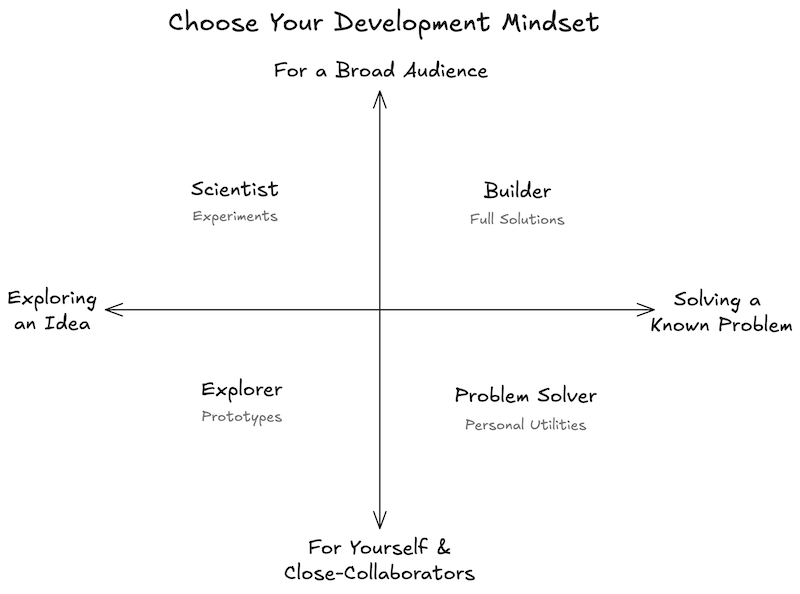AI-powered development tools are becoming more accessible and helping people without professional coding skills turn ideas into complex applications. But if you begin with the question, "Which AI-powered development tool should I use?" you may be stuck before you even start, spinning your wheels evaluating features or held back by a tool that adds unnecessary complexity.
Here's a better approach: Start by picking your mindset, not your tools. This framework helps you get there with two simple questions. With clarity on them, selecting the right tools becomes straightforward.
Two Questions to Shape Your Approach
Think about your idea and what you hope to accomplish, then answer these two simple questions:
What's your goal?
Explore an idea: You have a concept, but you aren't sure how it will work. You need feedback from others. You're open to changes based on what you learn.
Solve a known problem: You have a clear understanding of the need. You have evidence that your solution will work.
Who are you building for?
Yourself and close collaborators: You're creating something for people who understand its purpose and limitations. Users can provide direct feedback and work around quirks.
Broad audience: You're building for people who won't have direct contact with you. Users expect reliability and a professional experience.
The Four Mindsets
Once you've answered these two questions, you'll find your project in one of the four quadrants, each with different approaches to how you think about and build your application.

The Explorer (Prototypes): The Explorer mindset is perfect for validating a concept quickly without investing too much time. Your goal is to create digital sketches—they don't need to be perfect, but they should communicate your idea clearly and test the areas you are least certain about.
The Problem Solver (Personal Utilities): The Problem Solver is focused on creating tools to address specific, well-understood problems, often just for yourself or a small team. You're not trying to build the next big thing, you just need something that makes your life easier in a particular situation.
The Scientist (Experiments): As your project grows beyond initial success, you might eventually adopt the Scientist mindset. This becomes relevant when you have a working solution with real users and need to methodically optimize and improve it at scale. Most new projects will start with either the Explorer or Problem Solver mindset.
The Builder (Full Solutions): When you have a clear problem, a proven solution, and a need to build something that will hold up to whatever gets thrown at it, you need the Builder mindset. This is for creating robust applications that will be reliably used by many people over time.
Be realistic about where your project really is right now. Your goal may be to serve millions, but if your next step is testing a prototype with a small group, you are an Explorer.
The Impact of AI Tools for Each Mindset
Each mindset changes how you interact with AI development tools.
Explorer: Use AI for rapid iteration and generating multiple approaches. Focus on learning what's possible. Make peace with the idea that everything you make will get thrown away.
Problem Solver: Emphasize functionality over form. Direct AI to focus on your specific problem, avoid generalized solutions. Be explicit about your requirements and constraints. Start small.
Scientist: Design for measurement and feedback. Balance code quality with the need for adaptability. Use AI to increase the speed of iteration based on test results.
Builder: Leverage AI-powered developer tools to increase the speed of feature development. Focus on architecture, reliability, maintainability, and security. Use AI to generate documentation and tests.
Common Mistakes and How to Avoid Them
Adopting the Wrong Mindset: Many people adopt the Builder mindset prematurely, trying to create a full-featured product that can handle the thousands of users that are surely right around the corner. This makes it hard to quickly adapt to feedback. Start with the Explorer or Problem Solver mindset and evolve as you learn.
Skipping the Learning Phase: Even if you think you understand the problem perfectly, spending some time in the exploration phase will almost certainly reveal an assumption or "unknown unknown" that needs to be accounted for.
Mindset-Tool Mismatch: Using a tool designed for one mindset while trying to operate in another creates friction. Using a complex development framework while you are in Explorer mode will slow you down unnecessarily.
You will migrate between mindsets as your project progresses. AI-powered development tools have reduced the cost of experimentation, so take advantage of that by starting simple, learning from what you build, and evolving your approach over time.
Getting Started Today
Ready to build? Here's a simple way to get started:
Assess your situation honestly: What are you trying to accomplish and what constraints are you working with? What don't you know yet?
Choose your starting mindset: Explorer, Problem Solver, Scientist, or Builder?
Select tools that support your mindset: Now (and only now) choose the right AI-powered development tools that align with how you need to work.
You don't need to be a developer to build with AI. But you do need clarity about your goals, the right mindset, and the willingness to learn and adapt as you go. So what will you build?